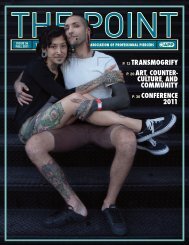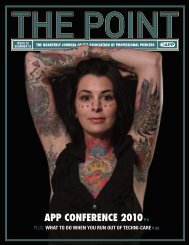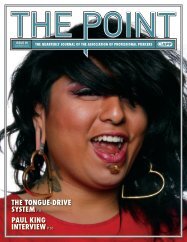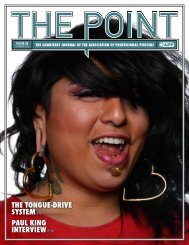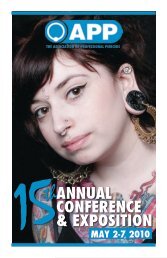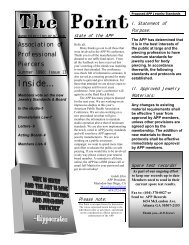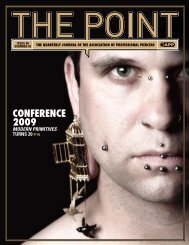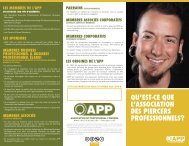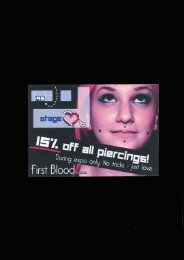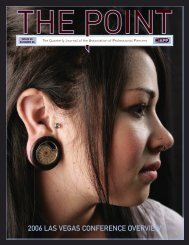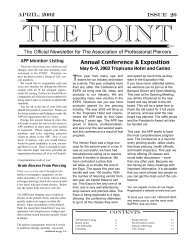the point - Association of Professional Piercers
the point - Association of Professional Piercers
the point - Association of Professional Piercers
You also want an ePaper? Increase the reach of your titles
YUMPU automatically turns print PDFs into web optimized ePapers that Google loves.
FROM THE OUTSIDE, LOOKING IN<br />
REFLECTIONS ON THE APP CONFERENCE,<br />
MEXICO CITY 2006<br />
Jason Pfohl<br />
Gorilla Glass<br />
Oaxaca, Mexico<br />
As an American living in Mexico I am occasionally asked about <strong>the</strong><br />
new wall <strong>the</strong> U.S.A. has begun constructing on its sou<strong>the</strong>rn border,<br />
attempting to “secure <strong>the</strong> border” with Mexico. I try to explain that<br />
<strong>the</strong> wall is political, not physical, and that not everyone supports<br />
walls and security cameras. I am always greeted with polite skepticism;<br />
everyone knows Americans are apa<strong>the</strong>tic.<br />
The good news is <strong>the</strong> first APP Conference in Mexico was anything<br />
but apa<strong>the</strong>tic. This event was a true reaching out across linguistic,<br />
cultural, and political borders.<br />
In Mexico it is not uncommon to see piercing and tattooing done<br />
on <strong>the</strong> street without gloves or sterilization. In <strong>the</strong> historic center <strong>of</strong><br />
<strong>the</strong> city, on Argentina Street, you can find city blocks full <strong>of</strong> jewelry<br />
<strong>of</strong> <strong>the</strong> cheapest substandard quality. In this predominantly Catholic<br />
society, job discrimination because <strong>of</strong> piercings is commonplace,<br />
and tattoos have an indelible criminal stigma. Despite, or perhaps<br />
because <strong>of</strong>, <strong>the</strong>se stigmas, piercing is flourishing in Mexico. I read a<br />
report estimating that <strong>the</strong>re were 1,000,000 piercings performed in<br />
Mexico City alone in 2004. I am sometimes surprised at <strong>the</strong> number<br />
<strong>of</strong> full facial tattoos and extreme body modifications I see -- a radical<br />
rejection <strong>of</strong> <strong>the</strong> current and dominant social norms.<br />
In this enthusiasm for body art <strong>the</strong>re is sometimes an abandon <strong>of</strong><br />
caution and a vacuum <strong>of</strong> basic information. Now with <strong>the</strong> emergence<br />
<strong>of</strong> a third and fourth generation <strong>of</strong> new Mexican piercers, <strong>the</strong>re<br />
is a hunger for information and betterment <strong>of</strong> <strong>the</strong> technique and<br />
possibilities in <strong>the</strong> art. Indeed, <strong>the</strong> conference exceeded maximum<br />
capacity (<strong>the</strong>re was only room for one hundred people). This was also<br />
evidenced in <strong>the</strong> attention and participation <strong>of</strong> <strong>the</strong> piercers. The new<br />
generation wants information. Obviously <strong>the</strong> APP Conference is just<br />
ano<strong>the</strong>r stepping stone in a long process; it is <strong>the</strong> piercers <strong>the</strong>mselves<br />
who have <strong>the</strong> responsibility <strong>of</strong> raising <strong>the</strong> standards.<br />
Amongst <strong>the</strong> instructors <strong>the</strong>re was also a tangible enthusiasm and<br />
excitement. By reaching outside <strong>of</strong> <strong>the</strong> usual venues and circles, <strong>the</strong>re<br />
was an opportunity for self-reflection and a renewal <strong>of</strong> purpose. In<br />
contrast to <strong>the</strong> APP in Las Vegas, <strong>the</strong> absence <strong>of</strong> <strong>the</strong> vendor show in<br />
Mexico afforded a clear focus on education and information; corporate<br />
rivalries and politics were circumvented altoge<strong>the</strong>r. The APP<br />
Conference in Mexico was educational, first and foremost.<br />
As cultural ambassadors and guests, <strong>the</strong> APP instructors and Board<br />
Members continued an exchange and extension <strong>of</strong> earlier relationships,<br />
both personal and pr<strong>of</strong>essional. Ana Paula and Danny Yerna<br />
have been involved in <strong>the</strong> APP for years. Their organizational and<br />
translating skills, and hospitality was inspirational and heartfelt. The<br />
cultural exchange was evidenced by several extra-curricular activities;<br />
canal rides with <strong>the</strong> mariachis in Xochimilco, field trips to <strong>the</strong> Anthropology<br />
Museum, and a pilgrimage to <strong>the</strong> Temple <strong>of</strong> <strong>the</strong> Sun in<br />
Teotihuacan. This exchange was exemplified one evening in Coyocan,<br />
when APP president Alicia Cardenas, who is part <strong>of</strong> an Aztec<br />
dance troupe in <strong>the</strong> U.S., joined a group <strong>of</strong> traditional Aztec dancers<br />
in a downtown park. The sparks in <strong>the</strong> eyes <strong>of</strong> <strong>the</strong> dancers, <strong>the</strong><br />
enthusiasm <strong>of</strong> <strong>the</strong> drummers, and <strong>the</strong> exchange <strong>of</strong> food and thanks<br />
afterwards was all evidence <strong>of</strong> bridges, ra<strong>the</strong>r than walls that <strong>the</strong> APP<br />
is helping to build between neighbors.<br />
24 T H E P O I N T ISSUE 35



